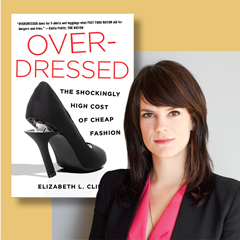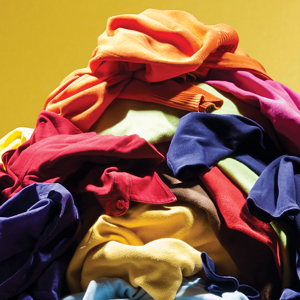When I was a kid, back-to-school shopping was a big deal because my mom would outfit us for the whole year. I remember parading around the dressing room in outfits while my mom humiliated my brothers by testing the roominess in the crotch of their pants. Our clothes would be tucked and hemmed, so later they could be let out and let down. There would be a new dress for Easter service, but for the most part, our clothes shopping was limited to the fall.
A lot has changed since then. Stores have moved from seasonal merchandise to monthly displays. Manufacturers produce and retailers stock generic clothes in enormous quantities to keep costs low, causing consumption to skyrocket. As a result, leggings and groceries now mingle in our carts at Target. When a trend, like the maxi-skirt, passes, we give it to Goodwill and move on to the new it item. In the meantime, if it gets stained or torn, we just get a new one on sale. Why alter, mend, or repurpose our kids’ clothes when we can cheaply buy something new, right?
I don’t know about yours, but my children’s dressers are crammed with clothes; still they often have nothing of higher-quality for when grandma comes to visit. Fabrics fade quickly in the wash or pill after only a couple of wears. I got frustrated with my kids for not taking care of their clothes – so what if they left a jacket at school or got ink on a shirt – until I realized they were merely adopting my disposable attitude towards clothing. That’s when I knew it was time to read Overdressed: The Shockingly High Cost of Cheap Fashion by Elizabeth L. Cline.
take your conscience shopping
Like the author, over the years, I have scoured outlet malls and discount stores for bargains, only to find my closet stuffed with low-quality clothing I barely wear. I’m addicted to steals and deals, like most Americans, having no idea what the implications of my actions are. A perfect example is the fact that I drive an eco-friendly Prius, yet I wear $20 cotton dresses from Old Navy made in Third World countries, where environmental pollution and human rights violations are atrocious. It’s a far cry from living my values.
According to Cline, “The United States now makes two percent of the clothing its consumers purchase, down from about fifty percent in 1990.” I knew American jobs were being outsourced, but that statistic really got me. Apparently, this shift is attributed, in large part, to one popular retailer’s marketing tactics during the nineties to convince America that “buying generic T-shirts and jeans was our key to the fashion castle,” Cline explains. It wasn’t long before all kinds of stores were offering consumers cheaper fashion, thanks to celebrity designers and cut-rate labor abroad. And despite the American garment industry’s rebranding as high-end, it’s been a struggle to survive, which is why, according to Cline, it’s been one of the fastest-dying industries in the United States in the last decade.
Part of the problem is that we think that by donating our cheap clothes, their afterlife will justify our only wearing these items a few times. “Most Americans are thoroughly convinced there is another person in their direct vicinity who truly needs and wants all of our unwanted clothes,” Cline argues, “This couldn’t be further from the truth.” The reality is charities can no longer sell all of the wearable clothing they are given and sending it overseas is no longer a viable option either, since Chinese imports have now begun to flood those regions as well.

join the slow clothes movement
So if you feel like you’re at a closet crossroads, as Cline was and I now am, then it might be time to join the slow clothes movement. First, you’re going to need to accept that clothing that is well-made is not cheap, which means you’ll own less, but pay more. If you do this, Cline says, you won’t spend more each year, but you’ll own much nicer stuff. Remembering “the price you pay for things is connected to other people’s paychecks” helps, too, insists Cline.
We also need to stop gravitating towards uniform, insubstantial clothing and seek out unique, well-built pieces that can be tweaked instead. This might require some courage, as it’s tempting to follow every passing trend whether it flatters your body or not, but Cline feels it’s worth developing your own look. She believes, “Most people are far more particular about their style than they realize, which is partly why we feel so frustrated with the clothes in our closets.”
consider consignment
If you can’t bring yourself to pay top-dollar to invest in a couple of key pieces, then get cozy in consignment stores. Almost every holiday outfit my children have ever owned has come from a second-hand store – most of the time with the original tags still on them.
Clover in Carytown opened in 2010, and is one of three consignment stores operated by Lyn Page and Jane Crooks. It’s a kid-friendly shop that sells maternity clothes in addition to children’s styles at a fraction of the retail price. They started the business, Lyn says, “Because our friends, along with Clementine’s [their first store] consignors and customers, encouraged us to open a store where they could consign their kids’ clothes and buy high-quality, top brands at great prices.” Clover took off so quickly it had to relocate in order to double its selling space, and Lyn says they have consignors booked months in advance. At Ashby, Clover’s sister store for young women and men, there’s a bathtub and everything in it is sold for two bucks per pound with all of the proceeds going to a local charity, so your bargain shopping really can help others.
Joan Williams, the grand dame of consignment in Richmond, knows a lot about preowned clothing and shopping trends. She founded The Hall Tree forty-one years ago. With Joan now in her eighties, the current store manager, Maureen Olson, told me new inventory coming in four to five days a week keeps the founder’s desire for an “element of surprise” possible. According to Maureen, their men’s clothing department has grown the most over the years, “Now it’s the whole family shopping here.” But Maureen says the Hall Tree’s high-end stock sells right away since there is less of it. With more and more of what Maureen calls “cute throw-away clothes” in stores these days, The Hall Tree has to be really careful about what they take in order to give shoppers the quality they’ve come to expect.
find a seamstress (or learn how to sew!)
While consignment items are ideally ready-to-wear, sometimes alterations are required to get the most out of an outfit. If you’re part of the lost generation, like Overdressed author Cline and me, then you may lack the sewing skills necessary to alter an item you acquired. Have no fear. There are plenty of places that can do the alterations for you, even your dry cleaners.
While expert seamstress Karen DeMarino of Midlothian specializes in costume design, she also handles women’s, men’s, and children’s clothing, along with formal attire and tailoring. She has been using the term disposable clothing for years to describe the sheer, uneven cottons we see on the racks that shrink after one wash. “People think it’s a style, but it’s not,” Karen explains. “The quality of fabrics has just really deteriorated over the years.”
That’s why Karen loves to shop for vintage clothes because the fabrics are so much better. “Since I know clothing construction, I can buy vintage fabrics and modernize designs.” Karen frequents Goodwill stores, which due to excess inventory, have started selling the previous week’s items for a dollar at the start of the next week at some locations.
Karen has been sewing since she was seventeen, when she was lucky enough to have a high school teacher show her how to read a pattern, determine the grain of a fabric, and learn how to use a sewing machine. Since then, Karen has continued to master her craft and learn short cuts from other seamstresses she works with when serving on the costume committee for her daughter’s theater company.
After reading Overdressed, I dusted off the sewing machine I got for my sixteenth birthday, determined to get it up and running again. My grandmother was a wonderful seamstress, and she’d be appalled to know I can barely sew a button on. For years, my daughters have been begging me to let them make something to wear. Every time American Girl Magazine arrives at our house, my 11-year-old is up in her room repurposing one item or another, most recently an oversized T-shirt into a gymnastics bag. Why not encourage her further? At least I’ll be investing in a practical skill they’ll use the rest of their lives.
According to Cline, learning to sew wasn’t about making everything she was going to wear, rather a lesson in how clothes, like styles, are always evolving. Once you realize that everything in your closet can be rebuilt, Cline believes it offers people endless fashion possibilities. Whether you need a refresher on the home economics classes of your youth or you are a blank bolt of fabric with no idea where to begin, Richmond has the options you need. This fall, the Visual Arts Center offers an intro to sewing class for adults and teens, as well as a more advanced class. You’ll even find classes at local retailers, like Joann Fabrics.
Essentially, Cline believes, “If we just patronize these places [disposable clothing retailers] at even half the pace that we do, it would put enormous pressure on the industry to clean up its act. No matter where our clothes are purchased, we should buy the best we can, make good use of them, and care for them.” Like anything, you’ll have to figure out how best to adopt these principles of reuse, alter, mend, and make to best fit your family, but these lifestyle changes are in all of our futures so why not start your own trend.
Shop Smart
Local seamstress Karen DeMarino offers up these strategies for shopping second-hand.
•Buy off-season for the best bargains and the best fabric selections. For example, Karen likes to purchase suede and leather pieces in the summer and repurpose them into patchwork purses and pillows.
•Always buy bigger for alterations. “If you let fabric out, you’ll see the stitching or wash line,’ Karen explains. “But to take items in is easy.”
•Think of creative ways to reuse fabrics. For example, Karen uses old sheets for men’s pajama bottoms, adds fabric to the bottom of shirts to transform them into dresses, and removes sleeves from winter garments so they are suitable for summer.




